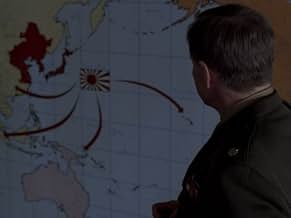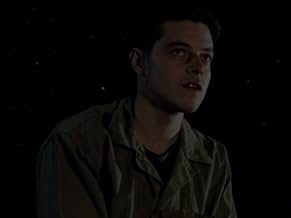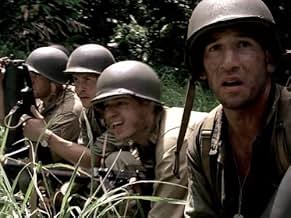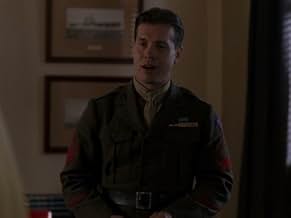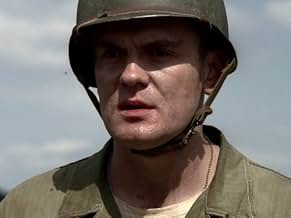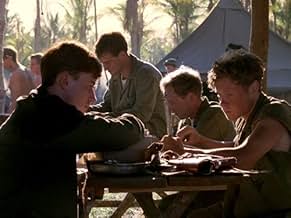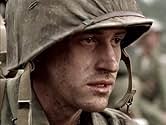द्वितीय विश्व युद्ध का प्रशांत रंगमंच, जैसा कि कई युवा नौसैनिकों की आंखों से देखा जाता है.द्वितीय विश्व युद्ध का प्रशांत रंगमंच, जैसा कि कई युवा नौसैनिकों की आंखों से देखा जाता है.द्वितीय विश्व युद्ध का प्रशांत रंगमंच, जैसा कि कई युवा नौसैनिकों की आंखों से देखा जाता है.
- 8 प्राइमटाइम एमी जीते
- 36 जीत और कुल 44 नामांकन
एपिसोड ब्राउज़ करें
फ़ीचर्ड समीक्षाएं
The Pacific miniseries will leave many of you in a state of awe. What a cinematic achievement. The best of the best of what American entertainment has to offer. The scenes and emotions portrayed are so vivid and lifelike that you'll think you've been transported back in time to the pacific theater of war. History has told us how horrid the war against the Japanese was. A war of attrition. This series will take you there and slap you on the wrists and then the face and remind you of the truth. War is utter diabolical hell. And the guys that fought in the pacific during WW2 were tough as nails. Tougher. It's ugly and beautiful at the same time. Enjoy and take a history lesson. You'll thank your lucky stars you did.
10follis12
The war in the Pacific was a hell of a lot different than the war in Europe. Of course both where terrible - full of death, sacrifice, and heroism. However, it seems the soldier's stories from the European theater have gotten a lot more press.
The US Marines in the Pacific lived like animals in the most horrible environments imaginable. On top of fighting an enemy committed to kill them at all cost and never surrender, they battled the mud, heat, malaria, near starvation, and isolation for months on end.
Basically, it was a total nightmare, and the heroism of all the US Marines in the Pacific theater is nothing short of awe inspiring. The Pacific tells this story well. It is a must see on the topic of WW2.
The US Marines in the Pacific lived like animals in the most horrible environments imaginable. On top of fighting an enemy committed to kill them at all cost and never surrender, they battled the mud, heat, malaria, near starvation, and isolation for months on end.
Basically, it was a total nightmare, and the heroism of all the US Marines in the Pacific theater is nothing short of awe inspiring. The Pacific tells this story well. It is a must see on the topic of WW2.
I couldn't tell you how many times I have watched Band of Brothers. I think it is the best production ever made. However, I resisted watching The Pacific. My father had five years active duty in the Marine Corps when I was born, and remained on active duty until I was 30 years old. I was ten when he left for Viet Nam, the first time, and in high school the next. I had friends whose fathers were seriously wounded, or killed, there. I have always felt like Marines are family, and any depiction of them being killed has always been hard to see. However, I finally decided to "man-up" and watch it, on Veteran's Day this year.
I think BoB was a dream come true for the producers. They had ironclad characters to follow all the way through, and many of the men were still alive and took part in it. The story of Easy company had been put into book form, brilliantly. They didn't have that with The Pacific. The closest they could come was to base it all around three separate men; Robert Leckie,Eugene Sledge and John Basilone. The three men's paths crossed, some,but they did not belong to the same units or know each other, although Leckie and Sledge both knew Basilone's reputation.
As brutal and difficult as the war in Europe was, the Pacific war against the Japanese was almost incomprehensible. Except for their time in Australia, following Guadalcanal, they were fighting the most brutal fights in history, while in the most punishing places on earth.It is a wonder that any of them were ever able to return to civilization and dull the memories of those horrors enough to lead a more or less normal life.
Because of the brutality of both the enemy and the conditions they had to live and fight under, there isn't much in the way of light-heartedness. The Pacific is not as enjoyable as BoB. Anyone seeing it for the first time should not expect to be entertained. It is a bit more difficult to get into. I found it helpful to watch the first episode twice before going on. A little patience in getting to know the primary characters payed off. I also think being able to watch it all over the course of a few days, like I did, was much better than watching it as it was first presented, one episode each week for ten weeks.
There were some excellent performances in The Pacific. Someone else singled out Ravi Malek's portrayal of Merriel "Snafu" Sheldon as award worthy and I agree 100%! I loved William Sadler as LtCol. Lewis "Chesty" Puller, and I was also very impressed with Tom Budge as PFC Ronnie Gibson.
The three primary characters are portrayed worthily. I didn't think Joe Mazzello as Sledge developed his character as well as the other two. However, I ended up with only nine episodes on my DVR. The one I am missing is episode five, which I suspect is centered on Sledge, so perhaps the character will seem better developed to me after I see it. Jon Seda gave a fine performance as John Basilone, which was definitely the roll of a lifetime! I think my favorite of the three was James Badge Dale, as Bob Leckie.
I wasn't as depressed by seeing a portrayal of so many Marines being killed and wounded as I expected. That was partly because not many of them really looked like Marines to me. I have always said that you can put an actor in the Marine Corps uniform but you usually can't make him look like a Marine. There were a few, though, who were totally believable including Jon Seda. Others have commented on the length of the men's hair as being distracting and/or inaccurate. By my first memories, in the mid-late 50s, Marines were wearing the crew-cuts and flat-tops that they have worn ever since. However, I have pictures of my dad in uniform, from a decade earlier, with longer hair, so I think the producers knew what they were doing there.
Although I agree with most posters here, that The Pacific is not as good as BoB, it is still well-done and definitely worth seeing. I think watching it with an open mind, and avoiding comparisons, it is a good way to approach it.
One last comment I have is that I wonder why one young Marine, who was killed on Iwo Jima at age 17, was singled out in the tributes at the end. I assume they meant that to symbolize the thousands of young men who were killed, and it was very effective, IMO. But I would be interested to know why they chose the one they did; if perhaps someone involved in the production was a relative of the young man. I won't say his name for those who might not have seen it yet, but I will always remember it.
I think BoB was a dream come true for the producers. They had ironclad characters to follow all the way through, and many of the men were still alive and took part in it. The story of Easy company had been put into book form, brilliantly. They didn't have that with The Pacific. The closest they could come was to base it all around three separate men; Robert Leckie,Eugene Sledge and John Basilone. The three men's paths crossed, some,but they did not belong to the same units or know each other, although Leckie and Sledge both knew Basilone's reputation.
As brutal and difficult as the war in Europe was, the Pacific war against the Japanese was almost incomprehensible. Except for their time in Australia, following Guadalcanal, they were fighting the most brutal fights in history, while in the most punishing places on earth.It is a wonder that any of them were ever able to return to civilization and dull the memories of those horrors enough to lead a more or less normal life.
Because of the brutality of both the enemy and the conditions they had to live and fight under, there isn't much in the way of light-heartedness. The Pacific is not as enjoyable as BoB. Anyone seeing it for the first time should not expect to be entertained. It is a bit more difficult to get into. I found it helpful to watch the first episode twice before going on. A little patience in getting to know the primary characters payed off. I also think being able to watch it all over the course of a few days, like I did, was much better than watching it as it was first presented, one episode each week for ten weeks.
There were some excellent performances in The Pacific. Someone else singled out Ravi Malek's portrayal of Merriel "Snafu" Sheldon as award worthy and I agree 100%! I loved William Sadler as LtCol. Lewis "Chesty" Puller, and I was also very impressed with Tom Budge as PFC Ronnie Gibson.
The three primary characters are portrayed worthily. I didn't think Joe Mazzello as Sledge developed his character as well as the other two. However, I ended up with only nine episodes on my DVR. The one I am missing is episode five, which I suspect is centered on Sledge, so perhaps the character will seem better developed to me after I see it. Jon Seda gave a fine performance as John Basilone, which was definitely the roll of a lifetime! I think my favorite of the three was James Badge Dale, as Bob Leckie.
I wasn't as depressed by seeing a portrayal of so many Marines being killed and wounded as I expected. That was partly because not many of them really looked like Marines to me. I have always said that you can put an actor in the Marine Corps uniform but you usually can't make him look like a Marine. There were a few, though, who were totally believable including Jon Seda. Others have commented on the length of the men's hair as being distracting and/or inaccurate. By my first memories, in the mid-late 50s, Marines were wearing the crew-cuts and flat-tops that they have worn ever since. However, I have pictures of my dad in uniform, from a decade earlier, with longer hair, so I think the producers knew what they were doing there.
Although I agree with most posters here, that The Pacific is not as good as BoB, it is still well-done and definitely worth seeing. I think watching it with an open mind, and avoiding comparisons, it is a good way to approach it.
One last comment I have is that I wonder why one young Marine, who was killed on Iwo Jima at age 17, was singled out in the tributes at the end. I assume they meant that to symbolize the thousands of young men who were killed, and it was very effective, IMO. But I would be interested to know why they chose the one they did; if perhaps someone involved in the production was a relative of the young man. I won't say his name for those who might not have seen it yet, but I will always remember it.
The Pacific... every time I come across this series I always want to watch it again. The show really shows you what the soldiers that fought in WW2 felt and went through. It's series like this that keep the memory of those brave soldiers who fought for their country alive. And also, the opening theme is... Just hear it for yourself.
Please, for the love of God, please do not overlook this miniseries. I have seen way too many people who don't bother to see The Pacific because it wasn't like Band of Brothers. This was in no way, shape, or form meant to be like BoB. If you have studied WW2 at all, you would know that the war in the Pacific was a totally different war than the European theater.
I loved Band of Brothers, it was a great and realistic series of the harsh realities of warfare and the scars it can leave. The Pacific was much harder to watch than BoB ever was. BoB was all about the bonds formed in combat and how this can tear people apart. This grim series displayed how completely unprepared the US military was mentally for how truly horrific this war would be. Not only were you fighting the unpredictable and relentless Japanese soldiers, but you were also fighting the terrain. The dense woods, the heavy rain, the thick mud. Not to mention all the diseases that came with these harsh conditions. Water was a luxury in a lot of situations. The filmmakers brilliantly showed how this affected the fighting men, who became virtually hollow shells, their sanity teetering on the edge of their knives.
The Japanese killed everyone without remorse. One particular scene that gave me chills to witness was in the latter half of the series when a group of civilians was slaughtered by a Japanese machine gun nest while running to the American forces. One person, a child, started to crawl slowly to the lines, a couple bullet wounds on his body. One of the combat rookies wanted to run in to help the poor boy, but was kept back so they would not be shoot too. All the Marines could do was watch, as the helpless child was brutally killed after a bullet from that machine gun emplacement hit him in the back of the head and his body went limp instantaneously.
This is on par with Saving Private Ryan, another collaboration between Tom Hanks and Steven Spielberg, as one of the most horrific, gruesome, and realistic war dramas ever put to film. I highly recommend giving it a watch, but be warned: this series is not for the faint of heart.
I loved Band of Brothers, it was a great and realistic series of the harsh realities of warfare and the scars it can leave. The Pacific was much harder to watch than BoB ever was. BoB was all about the bonds formed in combat and how this can tear people apart. This grim series displayed how completely unprepared the US military was mentally for how truly horrific this war would be. Not only were you fighting the unpredictable and relentless Japanese soldiers, but you were also fighting the terrain. The dense woods, the heavy rain, the thick mud. Not to mention all the diseases that came with these harsh conditions. Water was a luxury in a lot of situations. The filmmakers brilliantly showed how this affected the fighting men, who became virtually hollow shells, their sanity teetering on the edge of their knives.
The Japanese killed everyone without remorse. One particular scene that gave me chills to witness was in the latter half of the series when a group of civilians was slaughtered by a Japanese machine gun nest while running to the American forces. One person, a child, started to crawl slowly to the lines, a couple bullet wounds on his body. One of the combat rookies wanted to run in to help the poor boy, but was kept back so they would not be shoot too. All the Marines could do was watch, as the helpless child was brutally killed after a bullet from that machine gun emplacement hit him in the back of the head and his body went limp instantaneously.
This is on par with Saving Private Ryan, another collaboration between Tom Hanks and Steven Spielberg, as one of the most horrific, gruesome, and realistic war dramas ever put to film. I highly recommend giving it a watch, but be warned: this series is not for the faint of heart.
क्या आपको पता है
- ट्रिवियाDuring his audition, Rami Malek (Snafu) noticed that the man running the camera was not, as is typical, a young assistant, but an older gentleman who was doing some "very elegant camera work." Midway through his scene, he realized that the camera operator was actually Steven Spielberg.
- गूफ़At about 1:20 into the opening credits, a Navy ship sails into view from the left. On the bow is a small vertical mast (the jackstaff) flying a small flag (the Jack). The Jack and jackstaff are only used when the ship is anchored or moored never when it is underway.
- कनेक्शनFeatured in The 62nd Primetime Emmy Awards (2010)
टॉप पसंद
रेटिंग देने के लिए साइन-इन करें और वैयक्तिकृत सुझावों के लिए वॉचलिस्ट करें
- How many seasons does The Pacific have?Alexa द्वारा संचालित
विवरण
- रिलीज़ की तारीख़
- कंट्री ऑफ़ ओरिजिन
- आधिकारिक साइट
- भाषाएं
- इस रूप में भी जाना जाता है
- Untitled World War II Pacific Theater Project
- फ़िल्माने की जगहें
- उत्पादन कंपनियां
- IMDbPro पर और कंपनी क्रेडिट देखें
- चलने की अवधि
- 1 घं(60 min)
- रंग
- ध्वनि मिश्रण
- पक्ष अनुपात
- 1.78 : 1
इस पेज में योगदान दें
किसी बदलाव का सुझाव दें या अनुपलब्ध कॉन्टेंट जोड़ें





